| Car 2596 | |
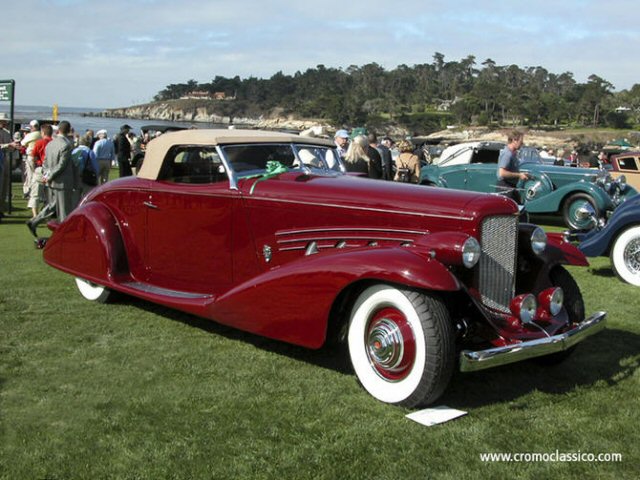 |
|
| 1935 Model SJ Duesenberg 2596, Bohman & Schwartz Convertible Coupe | |
| Engine No.: | Originally had J-572; J-509 [Picture] |
| First Coachbuilder: | Bohman & Schwartz |
| First Body Style: | Convertible Coupe |
| Wheelbase: | Short |
| Current Coachbuilder: | |
| Current Body Style: | |
| Original Owner: | Barbara Hutton, who gave it to Prince Serge M'divani |
| Owner in 1968: | Jerry E. Gebby, 298 Springfield, Dayton, OH |
| Current Owner: | John O'Quinn |
| References: | Adler, p. 134; Malks, p. 94; Elbert, pic. 156 |
Notes:
Display picture from cromoclassico.com
Notation from
Newport Collection: "Model J-572-#2596-SWB (original SJ)"
Sold at auction by Gooding & Company on August 16, 2009 for 3 million.
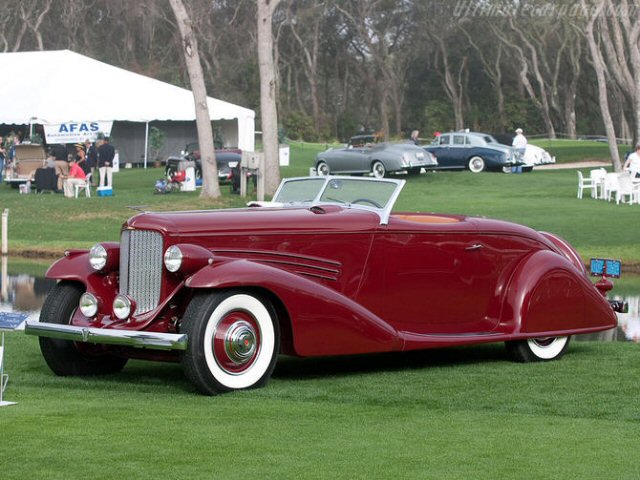
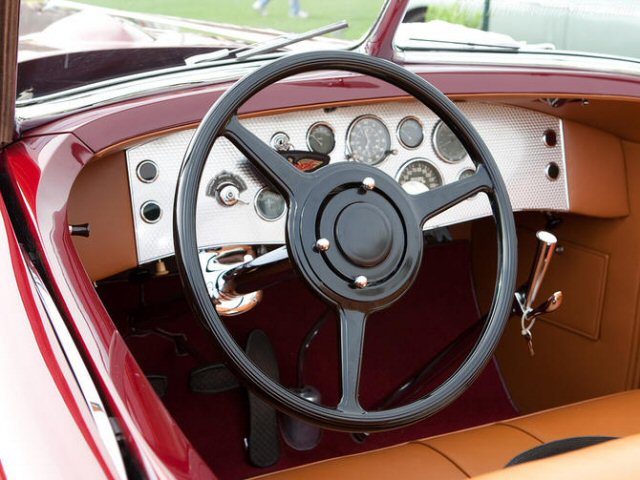
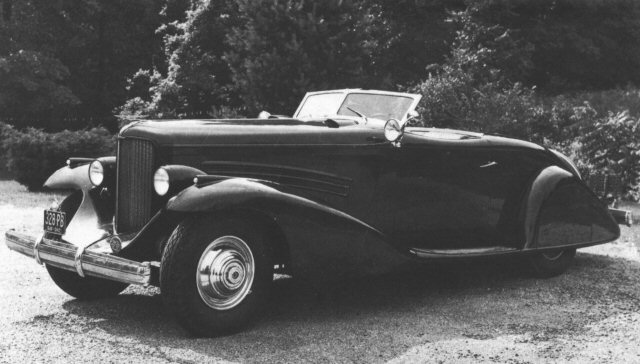
Picture from "Duesenberg The Pursuit of Perfection", p. 234.
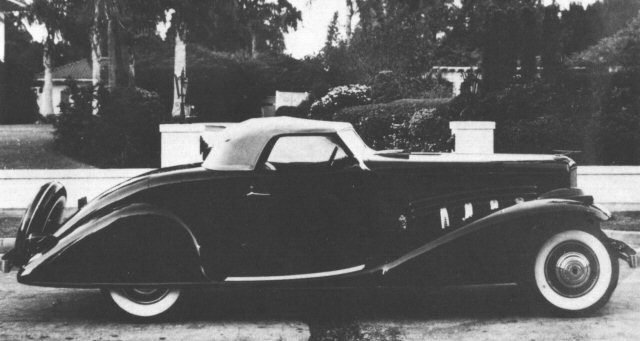
Picture from "Duesenberg The Pursuit of Perfection", p. 234.
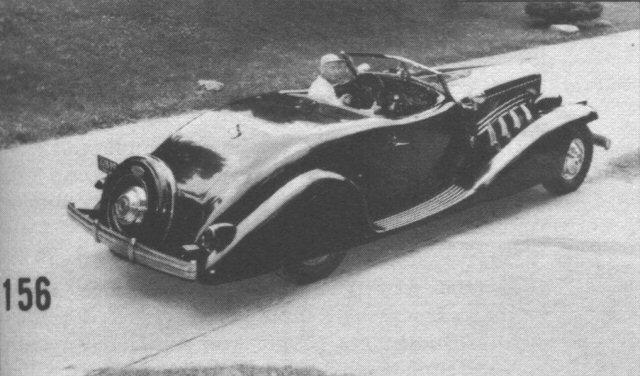
From www.coachbuild.com:
This wonderful one-off Duesenberg SJ
was built for Barbara Hutton, the heiress to the Woolworth fortune. Hutton was
well known for her extravagant generosity, and the car presented here is a
fitting example of her remarkable largesse. It was a gift for Serge M'Divani,
the brother of her lover Alexis M'Divani.
The famed M'Divanis were the children of Soviet Georgian nobles who fled Russia
during Wold War One. Despite their semi-royal status, the men of the family
earned a reputation as socialites, lotharios and womanizers. Prince Serge
M'Divani had settled in the US and his brothers were connected to some of the
wealthiest women in America and were known to marry each other's former lovers
and even former wives. Such was the situation that led to the construction of
this magnificent Duesenberg. In 1933, Barbara Hutton had fallen for Alexis
M'Divani, the brother of Serge M'Divani. Believing his affair with Hutton would
turn out to be even more promising, Alexis had recently divorced Louise Astor
Van Alen. Throughout their marriage, both brothers took great advantage of
Hutton's incredible wealth and status, and were in receipt of money, gifts and
property.
Every coachbuilder has a design that clearly stands above the others for its use
of proportion, daring construction methods and harmony of theme and detail.
Among Duesenberg enthusiasts, coachbuilding connoisseurs and designers, this
one-off SJ Roadster is hailed as the most successful Bohman & Schwartz design
for the Duesenberg chassis and an absolute triumph in the art of coachbuilding.
The original design was the work of W. Everett Miller, a highly regarded
freelance designer and one of the true artists of the Classic Era. Along with De
Sakhnoffsky, Al Leamy, Harley Earl and Raymond Dietrich, W. Everett Miller is
regarded as one of the most important and influential designers of the 1930s, an
era that is seen as the zenith of the coachbuilt automobile. By the 1930s,
Miller had worked as a head designer for two of the finest American firms,
Murphy and Locke & Co, and was enlisted by Packard to create a number of
stunning designs. This car was a fascinating segue in Miller's style that
reflected both his restrained use of line and detailing as well as his newfound
use of Art Deco themes.
This roadster features a number of remarkable treatments that are unique to this
particular car. Alas, Bohman & Schwartz never used these cues again as, by 1936,
the supply of Duesenberg chassis was limited. The tight, restrained proportions
and clean fresh lines of this model are rarely seen on other Bohman & Schwartz
Duesenbergs that, more often than not, incorporated the cues of the very
coachwork they modified. The difference with this Model SJ is that it was one of
only a handful of clean-sheet designs executed by Bohman & Schwartz on a bare
chassis, rather than an updated version of a pre-existing body. It should also
be noted that much of the body was constructed in alloy - a rare instance, as
the vast majority of Duesenberg bodies only use steel.
Prince Serge M'Divani took delivery of this supercharged Duesenberg Roadster in
1935. Its rakish good looks, grandeur and unbridled power were more than the
prince could resist. There is no doubt that the prince himself had an
irresistible charm and charisma that drew women to him, even the wives of his
siblings, and shortly after receiving the SJ, he married his brother's ex-wife,
Louise Astor Van Alen. Presumably, the car was briefly used in Los Angeles, just
after leaving the Bohman & Schwartz coachworks, and when he moved eastward in
February 1936, the SJ went with him.
Less than a month after their marriage, Serge M'Divani entered an international
polo tournament in Palm Beach, Florida. During an early match, his horse
collided with another. M'Divani was thrown from his horse and was kicked in the
head, killing him instantly. After Prince M'Divani's untimely death, Turner &
Blood, the famed New York Chrysler dealer, took possession of the famous
Duesenberg and offered it for sale. According to the ACD Club, Melvin Clemens of
Bridgeport, West Virginia, purchased the Duesenberg sight unseen. After some
use, Mr. Clemens took the car to J. Roger Davis, a well-known Duesenberg
mechanic who undertook a thorough mechanical rebuild of the supercharged engine.
It is now believed that under Clemens' ownership, the car's original engine,
J-572, was placed in chassis 2268. The Prince M'Divani SJ was then given a
replacement engine in the form of a Duesenberg factory-display SJ engine, J-509,
which had yet to be used in any other car. For over a decade, the car remained
in Clemens' hands until it was sold to Mr. Jerry Gebby.
Jerry Gebby, a gun engineer from Dayton, Ohio, discovered this Duesenberg at the
end of WWII. His adroit engineer's mindset and his admiration for the grand
Duesenberg marque made this car his favorite, and he treasured the SJ for over
30 years. In 1935, he would have never been in a position to own such a fine
automobile; however, by the 1950s, a Duesenberg was relatively affordable.
Although a Duesenberg no longer carried the prestige and instant recognition
that it had before the wars, Mr. Gebby cherished the car and was said to have
kept his beloved possession chained to a tree next to his humble abode - little
more than a static mobile home.
Soon after acquiring his Duesenberg, Mr. Gebby painted it black and affixed a
special script that he designed to the front of the radiator. Not content with
simply making cosmetic improvements, the engineer designed and created a unique
four-carburetor manifold utilizing Stromberg 97s to coax as much power from the
supercharged straight eight as possible. He also affixed a number of interesting
"driver's features", including a prism that would allow him to more easily see
when a stoplight changed from red to green, a useful feature for street racing.
The car remained in Mr. Gebby's care until Steve Nanini, a well-known collector
of great American classics, purchased the mighty SJ in the 1980s, toward the end
of Mr. Gebby's life. Mr. Nanini had the car comprehensively restored by
Duesenberg authority Randy Ema, who dressed the coachwork in its current
burgundy over tan color combination. Soon after the car was sold to famed
collector John Mozart, who, many years later, sold it to Patrick Ryan, another
highly regarded collector. In its current ownership, the SJ Roadster was invited
to participate at the 2009 Amelia Island Concours d'Elegance, where Bohman &
Schwartz was featured. Fittingly, it easily won First in Class.